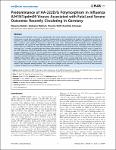Predominance of HA-222D/G Polymorphism in Influenza A(H1N1)pdm09 Viruses Associated with Fatal and Severe Outcomes Recently Circulating in Germany
Wedde, Marianne
Wählisch, Stephanie
Wolff, Thorsten
Schweiger, Brunhilde
Influenza A(H1N1)pdm09 viruses cause sporadically very severe disease including fatal clinical outcomes associated with pneumonia, viremia and myocarditis. A mutation characterized by the substitution of aspartic acid (wild-type) to glycine at position 222 within the haemagglutinin gene (HA-D222G) was recorded during the 2009 H1N1 pandemic in Germany and other countries with significant frequency in fatal and severe cases. Additionally, A(H1N1)pdm09 viruses exhibiting the polymorphism HA-222D/G/N were detected both in the respiratory tract and in blood. Specimens from mild, fatal and severe cases were collected to study the heterogeneity of HA-222 in A(H1N1)pdm09 viruses circulating in Germany between 2009 and 2011. In order to enable rapid and large scale analysis we designed a pyrosequencing (PSQ) assay. In 2009/2010, the 222D wild-type of A(H1N1)pdm09 viruses predominated in fatal and severe outcomes. Moreover, co-circulating virus mutants exhibiting a D222G or D222E substitution (8/6%) as well as HA-222 quasispecies were identified (10%). Both the 222D/G and the 222D/G/N/V/Y polymorphisms were confirmed by TA cloning. PSQ analyses of viruses associated with mild outcomes revealed mainly the wild-type 222D and no D222G change in both seasons. However, an increase of variants with 222D/G polymorphism (60%) was characteristic for A(H1N1)pdm09 viruses causing fatal and severe cases in the season 2010/2011. Pure 222G viruses were not observed. Our results support the hypothesis that the D222G change may result from adaptation of viral receptor specificity to the lower respiratory tract. This could explain why transmission of the 222G variant is less frequent among humans. Thus, amino acid changes at HA position 222 may be the result of viral intra-host evolution leading to the generation of variants with an altered viral tropism.
Dateien zu dieser Publikation
Keine Lizenzangabe
Verwandte Publikationen
Anzeige der Publikationen mit ähnlichem Titel, Autor, Urheber und Thema.
-
2016-02-18ZeitschriftenartikelVaccine effectiveness in preventing laboratory-confirmed influenza in primary care patients in a season of co-circulation of influenza A(H1N1)pdm09, B and drifted A(H3N2), I-MOVE Multicentre Case–Control Study, Europe 2014/15 Valenciano, Marta; Kissling, Esther; Reuss, Annicka; Rizzo, C.; Gherasim, A.; Horváth, Judit K.; Domegan, L.; Pitigoi, Daniela; Machado, Ausenda; Bella, A.; Paradowska-Stankiewicz, I.; Larrauri, A.; Ferenczi, A.; O´Donell, Joan; Lazar, M.; Pechirra, P.; Korczyńska, M. R.; Pozo, Francisco; Moren, A.Influenza A(H3N2), A(H1N1)pdm09 and B viruses co-circulated in Europe in 2014/15. We undertook a multicentre case–control study in eight European countries to measure 2014/15 influenza vaccine effectiveness (VE) against ...
-
2016-10-13ZeitschriftenartikelImproving influenza virological surveillance in Europe: strain-based reporting of antigenic and genetic characterisation data, 11 European countries, influenza season 2013/14 Broberg, E.; Hungnes, Olav; Schweiger, Brunhilde; Prosenc, Katarina; Daniels, R.; Guiomar, R.; Ikonen, N.; Kossyvakis, A.; Pozo, Francisco; Puzelli, S.; Thomas, I.; Waters, A.; Wiman, Å.; Meijer, AdamInfluenza antigenic and genetic characterisation data are crucial for influenza vaccine composition decision making. Previously, aggregate data were reported to the European Centre for Disease Prevention and Control by ...
-
2013-02-14ZeitschriftenartikelEarly estimates of seasonal influenza vaccine effectiveness in Europe: results from the i-move multicentre case–control study, 2012/13 Valenciano, M.; Kissling, E.We conducted a test-negative case–control study based in five European sentinel surveillance networks. The early 2012/13 adjusted influenza vaccine effectiveness was 78.2% (95% CI: 18.0 to 94.2) against influenza B, 62.1% ...

